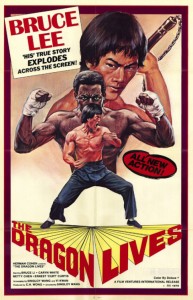
“The Dragon Lives” US Theatrical Poster
Director: Singloy Wang
Cast: Bruce Li (aka Ho Chung Tao, James Ho), Caryn White, Betty Chen, Ernest “Curt” Curtis, Joe Nerbonne, Fred Cargle, Li Won Chung, Elton Hugee, Jim Burnett
Running Time: 88 min.
By Joseph Kuby
There’s so much inaccuracies that it’s hard to tell if the filmmakers were being for real, trying to get a rise out of the audience or sharing an in-joke with the people who knew better.
Now I could write a sarcastic review like what Eric Clark (or Numskull as he’s otherwise known) did for his Bruce Lee: The Man, The Myth review (or like what Keith Dixon did for his Dragon: The Bruce Lee Story review over at the Many Bruces site) where I list all the “new” facts I learned about the life of Bruce Lee, but there’s way too many “new” facts for me to list here so instead I’ll just list the pros & cons that The Dragon Lives has going for & against it.
The Dragon Lives is a funny film on its own terms but for me a lot of the humour stems from people’s reactions to the film or imagining how people would react to the film.
Maybe I’m not the only one with this opinion but I always feel that a film can be funny or funnier when imagining, seeing or hearing what a person would look like or have to say if they were to watch it. For instance if people were to watch this movie, chances are there’ll be various reactions to the film whether it be humourously derogative, cynically critical or just plain dumbfounded.
A lot of the humour in The Dragon Lives can come from how seriously people could take it.
There’s two ways a person can take things seriously. A person can take things seriously in that they’re viewing things from a serious perspective or a person can take things seriously in that they’ll impart a level of importance to what they’re discussing or observing. For instance, you might have someone like me who watches Wong Jing’s films knowing fully well he’s not trying to make a serious statement, win awards or change society through politically charged cinema but will take him seriously because that person might realize that he’s a very talented and underrated filmmaker who’s better than the average filmmaker. A more better example for this is Stephen Chow’s Shaolin Soccer. It’s a funny comedy but people took it seriously because they felt it was a very good film that was being mishandled by Miramax.
People who watch Dragon Lives are more likely to take it seriously in that they think what they’re seeing is true. Some of you may laugh at this but don’t forget that one of the reasons as to why the Bruceploitation genre was going strong was due to people’s indifference (ignorance) as to whether they were seeing the real Bruce Lee or not.
Again, let me illustrate some examples. There was one particular time when the UK TV station Channel 5 had aired Dragon: The Bruce Lee Story. After when it aired, there was this Indian friend of mine called Waqas who thought Dragon: The Bruce Lee Story was accurate and he actually believed that Bruce had a fight with a Thai extra during the making of The Big Boss, now this is partially true but it was never blown up to such outlandish proportions as seen in the film.
I have another friend, called Leigh, and he was telling me about how he saw this movie featuring Bruce Lee in this orange tracksuit then I thought “Finally, someone realizes it’s orange!” before telling me that, in said flick, Bruce was thrusting his fingers & fists through various shaped holes in this training machine which measured hits through light bulbs and meters, then I realized that he wasn’t talking about Game of Death but Bruce Lee: The Man, The Myth. It was at this point I realized how the average person would react to a Bruce Lee biopic.
On further note, there’s this rental website I order films from, called Screen Select, where you can comments/reviews after when you’ve seen the DVD in question and when I looked at the Bruceploitation films available, there were all kinds of comments with one theme sticking them together: people go in expecting Bruce Lee only to find otherwise.
God knows what any of the above people would have to say about this flick!
Bruce Lee fans would go on about how Bruce is rolling in his grave, the average film goer wouldn’t get it, whereas film critics/historians might be able to look past the surface and appreciate its values. I think it’s fair to say that John Little would take The Dragon Lives as less lightly than Bey Logan. Fuck knows how Lee’s friends and family would react if they were to get their hands on this.
How I got my hands on this was through this competition that was held on the City On Fire forum back in early 2003 where the aim was to answer these factual/fictional questions about Bruce Lee’s life with answers that would make the makers of this film blush. I was one of the ten winners. The fact that I got it for free helped me to appreciate the film.
How Herman Cohen got his hands on this was back in 1981 when he decided that The Dragon Lives would be among his second* range of titles picked up for distribution through his company Cobra Media. Hence the references on the DVD and film itself that “Herman Cohen presents”. What grabbed his attention about the film was its quirkiness, horror elements (the eerie beginning & closing scenes and the training machine which haunts Bruce) and its hint of science fiction (the music that plays during Bruce’s knockdown at the Long Beach martial arts tournament and the training machine with noises that seemingly come straight out of Cohen’s sci-fi flicks).
Martial arts movies had something of a revival in 1981 thanks to the ninja sub-genre whose Western success was mainly due to Enter The Ninja therefore The Dragon Lives made enough money to ensure Cobra Media’s existence until 2002 when Herm unfortunately passed away. For those who want to learn more about Herm, go here.
The company who produced the film was Eternal Films, the same company who served as a low budget Golden Harvest for Indonesian Kung Fu star Billy Chong whose talent far exceeded their budgets in the same way Golden Harvest served as a low budget Shaw Bros. for Bruce. The Dragon Lives must be the biggest budgeted film Eternal Films ever worked on, even moreso than their Kung Fu Western (again, starring Billy Chong) called Sun Dragon (a.k.a. A Hard Way To Die).
However, I’m thinking this must have been a co-production as there are certain elements inherent in Bruce Lee’s Secret, namely the actor who plays Ho’s teacher and some of the Western actors (e.g. Robert Kerver {who plays a karateka in Dragon Lives} and the stoner I referred to in my review of Bruce Lee’s Secret). I’m also beginning to think there was a production manager who worked on both Dragon Lives and Bruce Lee: The Man, The Myth as both films contain actor Sham Chin Po (here he plays a Thai fighter whereas in the other Bruce biopic he plays Bruce’s sidekick Butchie), the same orange tracksuit pants, the same novel concept of larger-than-life training apparatus and even the same footage (of “Bruce” riding a cable car in San Francisco – complete with some of its riders waving & pointing at the camera).
I tried to find information on the Western actors in this film but I couldn’t find anything. The only thing about the Western actors that’s worthy of note is the soundalike (if not spellalike**) Jack Nickelson.
What’s reassuring of the film’s quality is that we have Ni Kuang as screenwriter (though he’s credited here as Yi Kwan – alternate spelling of his name Yi Kuang). It’s hard to judge a script on the basis of a dubbed track but the dialogue has some gems and occasionally contains every bit of punch as the fights do.
Get this funny line for instance…
“You’re playing in an American movie here and if I want you to walk around with a chopstick stuck up your ass then you’re gonna do it boy!”
Ni does a good job of turning a well known life into an unpredictable narrative. How can you hate a script where you have a black karateka-cum-wannabe gangster called “Elton The Black Devil’s Fist”?
One of the other things that holds this film together is James Ho Chung Tao’s performance as the legendary Bruce Lee. Even when the film becomes too silly for comfort, his performance is the one thing that remains constantly dependable. I prefer him to Jason Scott Lee as I always felt that whilst Jay was a passionate actor who captured Bruce’s magnetism & intensity, there were times when I thought he was downright cheesy – something I wouldn’t describe Ho’s performance as such given the nature of the film. In a sense Ho’s performance in this film is like Lisa in The Simpsons, a sane individual in insane situations where said person’s sanity can be compromised. His performance in Dragon Lives is one of his best and a firm reminder that he was a very good actor.
The main highlight for his acting talents is the scene where he tries to hitchhike a ride to the Long Beach martial arts tournament, his agony-ridden face overridden with desperation clearly conveys emotion which pages of dialogue couldn’t match pound for pound or ounce for ounce.
The Dragon Lives could be categorized as a Tingsploitation flick as well as a Bruceploitation one. One has to remember that Betty Ting Pei was a very big, if controversial, movie star. Even though she was nowhere near as huge as Bruce, she was big enough to inspire movie producers to find the next steamy sex sirens and I think Betty Chen (who plays Ting Pei) looks so much like her that she could easily have made B movie sexploitation movies in Hong Kong, their similar names just begs for commercial exploitation.
Speaking of commercialism, there’s quite a lot of things this neat little movie has going for it. You have one of the best theme tunes ever devised for a film (courtesy of Anders Nelsson and his band Ming – it’s definately up there with the Shaft theme and arguably better than it) and you have dubbing which may ring a bell with certain generations of audiences. For older audiences, Bruce’s teacher (when seen in the pre-credit sequence) sounds like British actor Michael York and for younger audiences, the pre-teen Bruce’s voice sounds like the voices we’ve come to associate with the animated show South Park. The guy who does the voice for Bruce’s rival, boxer Sam Curtis, is completely miscast dubbing-wise but that only adds to the Mystery Science Theater 3000 feel of this movie!
If there’s flaws I had to list, it would be that when Bruce is having to be spanked on the bottom by a cane (due to the order of his teacher), you can see that one of the senior students holding Bruce down is actually using his hand as some kind of alternative padding to make sure the child actor playing Bruce won’t get injured. Another flaw is when Bruce gets knocked down in his fight at the Long Beach tournament and the referee starts counting down from ten to one, it’s hard to believe that the flashback that occurs during Bruce’s knockdown would last that long before him being able to get up before the culmination of the countdown and still fight.
This is also one of the few films where criticism of dubbing can be justified. The tournament sequence features some lines of dialogue that aren’t dubbed when Bruce is speaking to his cop friend. After these two meet each other at the tournament, the dialogue that follows is obviously ad-libbed (i.e. made up as it went along).
Which reminds me, there’s a continuity error in the storytelling (if not in the visual transitions from shot to shot) but it wasn’t something I noticed due to how astonishingly absorbing this film is. Bruce’s buddy is depicted as a cop then for no reason he ends up being a sports reporter. Before Bruce finds out about the tournament via newspaper and runs off to get there in time, his buddy is still depicted as being a police officer who seemingly has no involvement with journalism unless maybe the implication was that the cop turned to journalism during the time it took Bruce hours to travel there (due to little resources). But this wouldn’t explain why the cop/journalist is surprised to see Bruce at the tournament given their last encounter.
The Enter The Dragon sequence is a bit incoherent because when the producers arrive at the shooting location (after walking past these bushes) they’re shocked to see Bruce fighting one of the Westerners when for all they know he could be fighting them under choreographed circumstances!
My final complaint would be the depiction of Sam Curtis’ record breaking blow of making eighteen opponents fall to the ground with one punch, one of the “injured” combatants is seen to be smiling! WHAT THE HELL?!…..pffft…..some punch!
I don’t think the inaccuracies and missing “pages” of Bruce’s life count as flaws seeing as how you can’t put everything about a person’s life on film and I don’t think the filmmakers were intending to be authentic with how they approached bringing Bruce’s life to the screen (though a lot of the humour can come from imagining that the filmmakers were being for real).
There’s many ways this film can be viewed. It can be seen as a parody of the many biopics covering Bruce’s life as well as lampooning success stories. You could even say that the film is lampooning Bruce’s life – poking fun at how people tend to over-exaggerate Bruce’s achievements (during a montage sequence, Bruce is depicted as being adored by loads of American citizens like he’s a national sports hero and is displayed on the cover of Time magazine). But it doing so they’ve made the film utterly devoid of cliche which isn’t something you can say with genre flicks.
It even mocks Bruce’s attempt of portraying realism of on-screen combat (or at least there’s a passing swipe being made at people who claimed that Bruce brought no-holds-barred realism to on-screen fighting). When Bruce is depicted as making Enter The Dragon, there’s a dispute with Western martial artists about how stagy movie fighting is to which Bruce responds by saying they’ll film the fight for real. It’s as if the filmmakers are sneering at the mere popular notion that Bruce’s on-screen bouts played like real fights, with no sense of rehearsal or routine.
If this was any other movie or if this was done by any other director, the film would have been seen as completely sloppy but due to the unique spin that’s been played on the telling of Bruce’s life story it kind of works. The zaniness is part of the film’s appeal. It’s like the producer told the director and screenwriter “Let’s make a film about a guy whose life is similar to that of the real Bruce but without the facts restraining us from making unpredictable storytelling and popular entertainment!”; with that mindstate it’s easy to see where the filmmakers were heading with this. They wanted to give the audience a fun and entertaining film but with Bruce’s name connected to it to sell more tickets, thus by disguising it with a slim veil containing the letters ‘biography’.
At least with Dragon Lives, some of its weakness are turned into strengths thanks to the absurd quality of the move. Take for instance the Hollywood producer who shows a constant, if curious, interest in Bruce Lee. After the success of the Long Beach tournament, the producer walks into this room where a party is thrown and despite Bruce standing half a metre in front of him, the producer fails to see him – in that his use of sight is questionable (he’s as blind as a bat), he looks at the far end of the room first before searching the nearer end of the room he’s based in. It never fails to make me laugh each time!
There are hints that The Dragon Lives was intended to be comedy such as when we see Bruce conveniently training in a playground whose idea of fun concerns lots of vertical wooden logs that are more ideal for a martial artist’s or a Shaolin monk’s ‘playground’ than that of a child’s. In one of the scenes featuring this location, James Ho Chung Tao seemingly goes out of character and pulls a face towards the camera whilst making some gestures with his hands that are apeing the preying mantis style of Kung Fu. In the second scene where we see Bruce hitting the logs, they appear to be made out of metal if sound (when turned up a few notches) is anything to go by!
We even have a parody of the Shaw Brothers movie making methods when Bruce is seen to be negotiating with a Chang Cheh-style director on the set of what looks like a deleted scene from one of Chang’s Heroic Bloodbath*** pictures.
The Disney-style music that weaves in and out of the picture like a professionally trained boxer should be enough to tell you that this is indeed a comedy! If it weren’t for the bloody tournament sequence, this would be seen as a PG take on the life of Bruce Lee.
Regardless of its childish moments, the soundtrack contains one of the most original scores ever produced for a Hong Kong film (besides one cue from The Sand Pebbles that can be heard in Dragon Fist). I think Anders is one of the world’s most overlooked music composers. The theme song, alone, is that great (for some reason, I can even imagine Homer Simpson singing it) and I think Anders’ score has some very good moments that’s refreshing given that it was made in an era where music cues were rehashed by the dozen. I liked the piano melodies that played during two specific scenes: when Bruce hears about his offer to be in Green Hornet and the montage sequence depicting Bruce’s discovery of Jeet Kune Do. I particularly liked the first piano melody, it brought over a sensitive & sensible side to this sometimes chaotic and childish movie!
Bruce’s cop buddy gives new meaning to the term “Keystone cops” and there seems to be this allegory being made about Bruce Lee treat like a dog. Again, this is due to the way biographers, cinematic historians and perhaps Bruce give the impression that Chinese are treat like dogs everywhere. When Bruce meets his cop pal for the third time in the aforementioned park, the cop gives him some food in the same vocal and physical mannerisms a person would give an abandoned dog some food! (minus the handshake of course, hehe) Later on we see Bruce in his personal swimming pool when a Hollywood movie producer comes to negotiate with him; during the first part of their conversation the producer starts rubbing Bruce’s head and speaking down to him in such a simplified & broad-faced manner you’d think that the filmmakers were also attacking the very notion of ‘political correctness’ in society.
Much has been made in past reviews of the film’s comedic nature, there really are loads of comedic gems to choose from as far as personal favourites are
concerned. Let’s put it this way, there’s as much comic highlights as there are inaccuracies. In fact there’s so much comedic highlights it’s hard to list them all down which I think is the key to a successful comedy and a surefire way to test how good your material is, whether you’re a stand-up comedian, television writer, play writer, film writer or, fuck, even book writer.
Nowhere is this more evident than in the Long Beach segment of the film. The film’s primary comedic highlight is, without question or argument, the Long Beach martial arts tournament which is probably the quintessential example of how far from the film strays from Lee’s life. I mean since when did wrestlers (besides sumo) come to figure in the martial arts (besides grappling arts like Hapkido, Aikido and Judo). We have guys in capes and with beards that are shaped like upside down afros. On certain occasions, you’d think that ZZ Top or Jews were auditioning to play extras in a martial arts flick! (or wrestlers auditioning to be a part of the ZZ Top phenomenon)
We also have one of the most cringe-inducing yet rip-roaringly hilarious bonding moments ever captured on film. It’s when Bruce meets both the cop/journalist and this other journalist (a black sports writer). The way they embrace each other’s company in such an open, vivid yet non-homosexual manner (it has to be seen to be believed) even has some of the staff & fellow reporters in the background reduced to laughter! (with a few of them taking pictures of this joyous {that’s putting it lightly & loosely} and ‘friendly’ event)
There’s unintentional humour as evidenced by extras in the audience as it’s pretty obvious that they’re laughing at the hokeyness of the flick. Perhaps an exception has to be made with the Thai boxer scene since maybe the idea was for the audience to laugh at how Thai boxers have to dance before a fight. At one point we see a woman laughing in hysterics (complete with body actions than only be described as body shock….think electrocution). Then there’s a kid in the audience who looks like Michael J. Fox but more chubbier (puppy fat?!) and then there’s the multimentioned stoner.
I remember a commment on Bey Logan’s audio commentary for Game of Death where he said something on the lines of “If you look closely you can see the audience are not having a good time being extras!” but their reactions to the Sammo Hung vs. Bob Wall fight look like authentic reactions that an audience makes when viewing public professional fighting events. It’s very obvious that the audience in Dragon Lives are laughing at the movie (i.e. derisively) or playing along with it (i.e. overacting to the extent that it looks like they’re scorning the movie in a sardonic manner). Obviously Bey Logan has not seen The Dragon Lives hence his comments on the Game of Death commentary.
The tournament has a wildly contrasting, almost schizophrenic, nature to it. When we see a black karateka meet his ugly fate at the hands (or head rather) of a Thai fighter, we have one side of the audience who are crying, covering their faces and with looks of shock, appall and disgust written all over their face; then on another side of the audience we see people cheering & laughing almost like what they were seeing was a harmless & light-hearted event!!!
Okay, so the people in the tournament are a little bit nuts but what about the actual tournament itself?……okay, well when was the last time you went to a “big”**** martial arts tournament and saw basketball hoops, usage of flashlights (yes, vehicle traffic flashlights), war-time stretchers (complete with paramedics who look like they’ve just come out of a hospital), an announcer who looks like Groucho Marx and walls that advertise food stands in big capital letters like “FRESH MILK” and “ICE CREAM”? The tournament is a joke, no wonder the audience is laughing!
There’s also these types of buzzers & beepers that seem alien to the world of fighting tournaments.
The film has above average production values for a Hong Kong movie. We really get our money’s worth courtesy of some foxy 70s chicks (even more foxier than Linda Cristal as seen in Mr. Majestyk*****). Besides one or two hot chicks we see in the tournament sequence, we have one fine looking lass who can be seen on the left hand side of the screen when people are watching the televised announcement of Bruce’s defeat of Samuel Curtis. Heck, the actress who plays Linda Lee here is more of a babe than Bruce’s wife! (definately not what I’d call the girl next door)
In terms of technical production values, the film is a little bit rough around the edges so it’s not entirely polished, but it does succeed in telling the story and we get some nice usage of colours and out-of-control camera effects during the more crazy moments of the movie! (I especially liked the zoom-ins used during Bruce & Betty’s hot night of passion, kind of hokey but I dig it)
There’s a nice attempt at symbolism during the much-mentioned bout of sexual combat (hehe) between Bruce & Betty. I think the hot water/coffee image is meant to symbolize that Betty will be in hot water (metaphorically speaking) over Bruce’s death or that a storm is brewing (hence what’s going on outside the room) or that maybe the sex is the calm before the storm (the storm being a figure of speech whose double meaning is the death of Bruce Lee himself).
A lot of symbolism is shown through the imagery and verbal quotations of time (throughout the film) thus the coffee scene representing that Bruce is running out of time! I think this plot device of using time as a strong visual and narrative element is something that may have influenced Tsui Hark for Once Upon A Time In China 2 (something which is partially confirmed by Australian film critic Stephen Teo in his book Hong Kong Cinema: The Extra Dimensions).
I like the way the director did this neat little trick where we see all these magazines, containing the face of Bruce, thrown onto this unknown surface with the last magazine containing his face on the cover of Time magazine then all of a sudden we go past the frame of the photograph and we see Lee from going static to energetic.
I think one of the things going for this movie is its texture, there’s so much happening visually that I ended up rewinding the DVD just to pick up all the visual nuances (something I don’t usually do in regards to my movie viewing habits) e.g. I wanted to see all the various magazines Bruce was standing by just so that I could get a peek into 70s culture (but not through the eyes of some Hollywood producer but just 70s culture seen through its undiluted, unadulterated, untainted and ultimately purest form). It’s because of this that I noticed that one of the Westerners who walks past Bruce is a guy wearing a T shirt that reads “Have A Shitty Day!”
Just to go over the stuff they actually got right in this picture, I’m surprised they were right about Bruce’s feelings of Jeet Kune Do and Bruce’s over-training much to the extent that he became anti-social.
…and the stuff they got wrong? Really the question should be “What did they get right?” since there’s so much stuff they fluff up but I’ve gone through that already. Well, Game of Death is referred to as The Last Game. Bruce is shown to be pleased with the international distribution of his first three action films (something which, in reality, was the other way round). Bruce never admitted that he was a show-off and his master never lived to see Bruce after the completion of Enter The Dragon.
The funniest assumption the filmmakers make is that during Lee’s self-destructing period, Linda actually wanted Betty to help him! (I think it’s safe to say that Linda would have wanted the opposite)
…and since when did Bruce live in a Hollywood-style estate in Hong Kong. I know documentaries and biographies say that Bruce’s home in Kowloon was nothing short of a palace (for Hong Kong standards) but this is ridiculous!
The DVD has the audacious verve to say that Ho trained with Bruce Lee as well as confusing the plotline (and alias) for that of Bruce Lee: The Man, The Myth.
Also, the biography featured on the DVD is wrong too.
Here’s what Carl Jones from the KFC forum had to say about this…
“I wrote that (horribly inaccurate in some places) bio/filmography on The Dragon Lives. At the time, Keith Dixon (creator of Bruceploitation site and weirdo) and I were given info about Mistaken Identity by a guy called William Wilson who claimed it was real. Unfortunately, we found out that 90% of the stuff he was saying/writing was made up. As it stands, Mistaken Identity is not a real film and we removed it from the site. Sorry for the confusion.”
Much has to be made of the similarities between this and Dragon: The Bruce Lee Story. We have the same over-glorified tournament sequence where everyone boos Bruce at first and when he springs back at the minute to fight a foe in the ring. We have the same idea of a Hollywood producer who betrays Bruce several times before coming to see him in Hong Kong to make things up with Enter The Dragon. Then there’s the notion that Bruce published Jeet Kune Do in book form. Eerily, there’s the training machine whose face resembles the demon seen in the 1992-made (though 1993-released) Bruce Lee biopic; though funnily there’s a point overbearingly brought across about Bruce detesting pig-tails.
But the reason for the many comparisons stems from one simple fact I almost overlooked about 8/10 into the typing of this review….Herman Cohen and Rob Cohen are related – father & son. So I guess Rob was either throwing several homages to his pops or his father gave him some of the “knowledge” he learned from The Dragon Lives.
If you’re an eagle eye when it comes to viewing anything whether it be films, paintings or photos then you’ll spot cameos of various Hong Kong actors, no-one famous but just regular faces you’ll see from time to time. Coincidentally, there’s three actors in this movie who appeared in another Bruceploitation movie that was made in the same year, New Fist of Fury. We have Hon Siu, Shih Ting Ken and Hau Pak Wai, I’m not gonna go to great lengths to describe their roles so if you happen to see this flick (and I don’t see why not) then check out this page to keep a note on who to look out for.
Ever so rarely in an action film of any kind, do you talk about the action as if it was the tertiary or quaternary****** element of a film. Usually it will be the primary or, at least, the secondary element of a film so the fact that it took me this long to get to the “How good the action is?” part of the review just goes to show you that The Dragon Lives can be viewed as a film as much as it can viewed as a martial arts film. To a larger extent, it goes to show you that an action film (particularly a martial arts film) can have many cinematic elements interspersed throughout if enough faith and patience is given by both the filmmakers and the audience! In the case of Dragon Lives, it shows the director had the brains, talent and overall deeper insight to deliver something that contained more than just one-way tickets to fight scenes.
As for the action itself, it’s not the most pleasantly shot action you’ll ever see nor will you confuse it for having intricate choreography this side of a Jackie Chan/Lau Kar Leung flick, but it is realistic and hard-hitting with impressive moves and cutting-edge moments of cinematography, which is something even the most ardent nitpicky naysayer couldn’t place a grudge against.
The editor for the film was a Westerner called Mike Harris. Editing is very important in an action sequence. Jackie Chan has said many times that it doesn’t matter if you have the best martial artist or the best director, if the editing sucks – it sucks! Of course things like camera speed, camera positioning and choreography are also integral. Thankfully, Harris’ work doesn’t have the usual editing problems usually associated with Western productions. His skillful, perhaps even masterful, editing reminds me of Sally Menke’s work on Kill Bill – their editing actually allows you to appreciate the fights in their visual splendour than wonder what the fuck just went on!
There are some fast-cutting techniques but they actually add a bit of distinguished flavour to the film rather than overwhelm it. Very rarely (apart from Sammo Hung’s Pedicab Driver) do we have a film where fast editing actually compliments the choreography of an action set-piece, though fight fans needn’t worry about seeing a non-stop continuity of blurred shots!
As for the choreography itself, besides a shameless rip of the Bob Wall vs. Bruce Lee fight reinvented between Bruce and Elton (where we see Bruce evade Elton’s flying kick with a kick to Elton’s groin), a lot of stuff on display here is fairly original like slapping an opponent’s ribs at both sides and one bit that impressed me was when Bruce was deflecting Sam’s punches repeatedly and quickly with the same hand!
As it stands, The Dragon Lives is a very good example of 70s pop culture and should be viewed as both as a historical artefact as well as a good film. Certainly, like 2001: A Space Odyssey, the film will come to be appreciated by hippies who will use it as an alternative to LSD. Very few films in the 70s were as warped and/or psychedelic as this! (unless you count Ken Russell’s films Lisztomania and Tommy – the latter which was originally going to be directed by George Lucas)
Really, The Dragon Lives is such a hallucinogenic ride that it could be easily compared to The Magical Mystery Tour and Head (some of the music heard near the end is reminiscent of Head). On a similar note, the animated Bruceploitation film The Story of Chinese Gods could be seen as Hong Kong’s answer to The Yellow Submarine.
Now if someone was to base their Bruce Lee biography on this…
* The Dragon Lives was picked up after Cohen after the success of Steel-Fisted Dragon which was one of the first titles he released under Cobra Media. To learn more about Cobra Media, go here.
** My own personal riffs on the word lookalike.
*** …or quinary, senary, septenary, octonary, nonary, denary. Words also exist for ‘twelfth order’ (duodenary) and ‘twentieth order’ (vigenary). But I suppose you get the point by now!
**** My attempt at pulling off a Rick Baker and coming up with a phrase used to describe Chang Cheh’s style of moviemaking which is equivalent to what John Woo did with his Heroic Bloodshed movies!
***** According to director Singloy Wang (who was also the co-writer of this flick), Bruce Lee was a big fan of Charles Bronson as can be seen if one was to look carefully for a poster of Charles’ face in Bruce’s office (this takes place in the scene prior to when Bruce accepts a ride {non-sexual that is} from Betty).
****** As in not a high-school gym ala No Retreat, No Surrender.
More on Anders Nelsson
Anders Nelsson was born in the U.S.A. and later lived in Hong Kong until his late teenage years (His parents were missionaries). He then moved to Sweden as he was required to do his military service there in order to retain his Swedish citizenship.
Anders Nelsson had already been a big popstar in Hong Kong, and Cool Candy’s band leader Einar Svensson tried to launch him on his new recording label, Anette Records, where Nelsson’s single became the company’s first release. Nelson also got to live with the Svensson family. The Kontinentals included some members from String Tones and Cads.
Anders Nelsson returned, however, to Hong Kong. His blond hair and blue eyes fit in well in Hong Kong.
Nelsson also recorded an album there together with a group called Inspiration, and one can assume there were even some singles released from it. Anders Nelsson also became a film star and enjoyed great success playing villains in James Bond-influenced films.
Anders Nelsson came from Hong Kong to Sweden. He showed up here in the middle of a winter cold spell. The first thing Anders said when he landed in Sweden was: “Brrrr! This is really cold! So this is what snow looks like.” You see, he had never experienced a Swedish winter and had never seen snow before, this despite the fact he was Swedish! How can that be? Well, now I’ll tell you a little about Anders so you can get to know him better.
Anders was born in California on June 10, 1946, of Swedish parents. He has only lived in Sweden a few months of his life.Ý For so many years Hong Kong has been his home. He went to school there (he took the GCE-exam, which corresponds to Sweden’s upper-secondary final exams) and, as well, became a top name in the music business. Together with his own group, The Kontinentals, Anders was Hong Kong’s most popular local band. The big breakthrough for Anders and The Kontinentals came with the group’s first single. One of Anders’ own songs, “I Still Need You,” became a big hit and went straight to the top of the charts. It even beat out such hits as the Beatles’ “Yesterday” (I guess it lends more credence to what I said about Anders being one of the best all-time composers).
When the offer came for him to move to Sweden, Anders and the Kontinentals were at the peak of their career. They had top billing at pop concerts and appeared often on radio and TV. But now the group had to split up, and Anders’ fans took this really hard. At The Kontinentals’ farewell performance at the Concert Hall in Hong Kong’s City Hall building, no one could hold back the tears. “It was really an amazing pop concert,” Anders says. “It was hard to sing. Everybody just cried.”
The day that Anders set off for Sweden, the airport was stormed by thousands of fans screaming: “Anders, come back. Anders, come back!” Although he had to leave, Anders was determined to pick up where he left off, starting up The Kontinentals again in Sweden. He’s a great guy, a bit shy perhaps but with a wonderful charm. Listen to his stuff, and then you’ll understand why he made it to the top so quickly. It didn’t take many of his lucky listeners long to realize he’s absolutely a world-class pop singer.
Now if only every single Westerner involved in Hong Kong film had set up their own personal site!
Jospeph Kuby’s Rating: 8/10
By Woody
By far the best movie I’ve seen in quite some time. No, it’s not “Citizen Kane.” Shit, it’s not even “Kickboxer.” It’s just a good, solid, funny Brucesploitation pick starring Bruce Li, my favorite old school martial artist. No, he isn’t the most charismatic guy, and yeah, the majority of his movies were shit, but Bruce Li just had a happy-go-lucky charm about him, and his movies reflect that attitude. Particularly this one. If you want to see an accurate account of Bruce Lee’s life, and you rent/buy a movie starring Bruce Li, you’ll get what you deserve, dipshit. If this movie were correct, Bruce Lee was a grinning idiot with some freaky death curse. I think this flick really benefits by playing off of Bruce Li’s charms instead of trying to fashion him after Bruce Lee. Even if that is who this flick is supposedly about.
Basically, if you are watching an old exploitation movie, you want to know what separates it from the rest. Well, off the top of my head…
– There is a great scene where Li is unable to hitch a ride.
– A never-ending wrestling match involving a tiny Chinese guy dressed as a Native American, who, after beating countless opponents, is thrown out of the ring by a really big Chinese dude with a Hitler mustache.
– Sam Curtis, the big, intimidating black guy, has a squeaky, high-pitched voice in the dub. One reason I will never be able to get enough of these old school movies.
– Never-ending sex scene with NO NUDITY! Must be seen to believed.
– Bruce Li at his absolute “aw shucks” best, either grinning widely or cracking wise throughout the whole picture.
– A comic relief fat slob cop. Great stuff.
– More than anything, the great disco soundtrack.
Peep the lyrics to the theme song: He’s a Legend, He’s a Hero
See his feet flying through the air like a hurricane.
He’s got hands of steel, and he always gets his man.
He’s a legend, he’s a hero,
He’s everything a man could be.
Little Dragon, he’s a hero,
He’s the man they call Bruce Lee.
He can kick so high, he can almost reach the sky.
He’s a kung fu king of the world and that’s no lie.
He’s a legend, he’s a hero,
But his life’s a mystery.
Little Dragon, he’s a hero,
He’ll go down is history.
Bruce Lee!
Bruce Lee!
He’s a legend, he’s a hero,
But his life’s a mystery.
Little Dragon, he’s a hero,
He’ll go down in history.
Bruce Leeeeeee!
If reading those lyrics dosen’t get you up, out, and buying the movie…hahaha….
And more than anything, it’s all in good fun. There is something so good natured about this particular Bruceploitation movie, it just had me kind of smiling. I’m not recommending this to the casual film fan, but if you are in the mood for some quality old school Bruce Li mayhem, this is the best I’ve seen in some time. Right up there with “Tower of Death” and “Image of Bruce Lee”.
Oh yeah, the VCI DVD is by far the best Brucesploitation presentation I’ve seen thus far…widescreen!
Woody’s Rating: 7.5/10





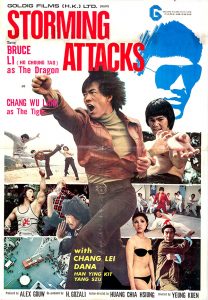
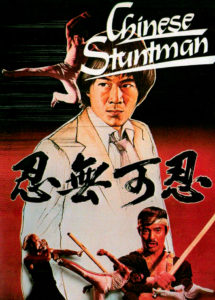
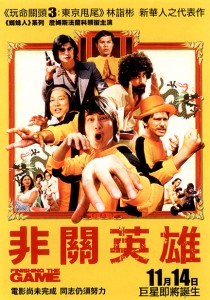

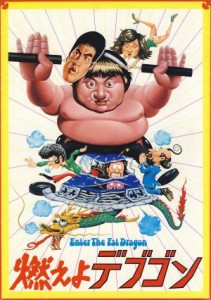
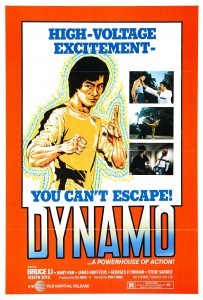
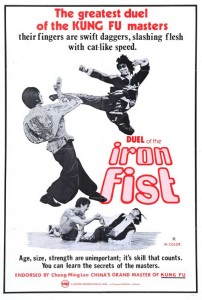
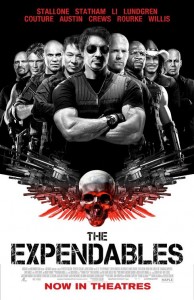
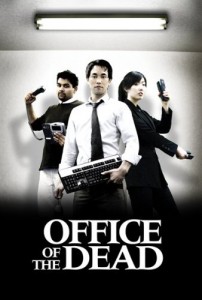
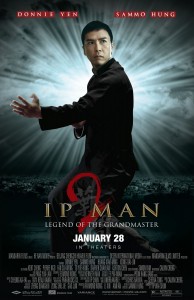
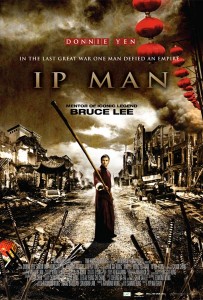
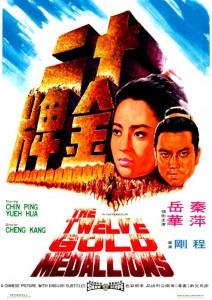
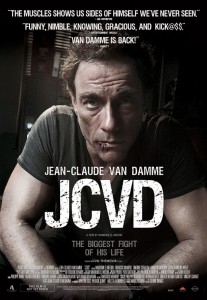
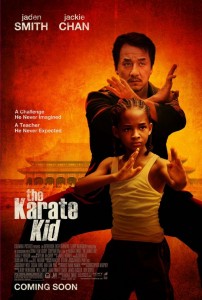
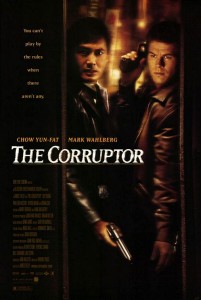




Be the 1st to Comment